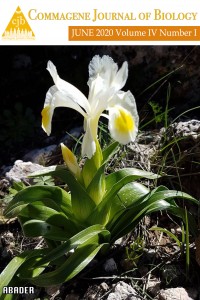Abstract
Birinci ve ikinci yılındaki Haçlı Kara kurbağaları (Epidalea calamita)'nın Hollanda kıyı kumullarının yakınında ilkbahardan sonbahara kadar bir binanın tuğla duvarında yer alan bir boşluğu ortak diurnal sığınak olarak kullandıkları tespit edilmiş ve aynı zamanda bu sığınağın kış sığınağı olabileceğinden şüphelenilmiştir. Sadece juveniller ve ikinci yılındaki bireyler gözlenmiştir. Daha büyük örnekler boşluğun önündeki metal ağdan dolayı girememiştir.
Keywords
References
- Drobenkov, S.M. (2018). Morphological variation and population structure of the Natterjack toad, Epidalea calamita, in northern part of the range in Belarus. Biologica Universitatis Daugavpiliensis, 18(1), 29-37.
- Kordges, T. (2009): Zum Einsatz künstlicher Verstecke (KV) bei der Amphibienerfassung. Zeitschrift für Feldherpetologie, Supplement 15: 327-340.
- Miaud, C. & Sanuy, D. (2005). Terrestrial habitat preferences of the natterjack toad during and after the breeding season in a landscape of intensive agricultural activity. Amphibia-Reptilia 26(3), 359-366.
- Pikulik, M.M. (1995). Status and Dynamics of Amphibian Populations in Belarus and the Influence of Anthropogenic Factors on Amphibians. In S.L. Kuzmin, C.K. Dodd and M.M. Pikulik (Eds.), Amphibian populations in the Commonwealth of Independent States: current status and declines. Pensoft Publishers, Moscow, Russia (pp. 21-35).
Abstract
First and second year Natterjack toads (Epidalea calamita) were detected around a building near the Dutch coastal dunes, using a brick wall cavity as a communal diurnal retreat site from spring until autumn, with the suspicion of this also being a winter refuge. Only juveniles and animals in their second year were seen. Bigger specimens were unable to enter due to the metal mesh in front of the openings.
References
- Drobenkov, S.M. (2018). Morphological variation and population structure of the Natterjack toad, Epidalea calamita, in northern part of the range in Belarus. Biologica Universitatis Daugavpiliensis, 18(1), 29-37.
- Kordges, T. (2009): Zum Einsatz künstlicher Verstecke (KV) bei der Amphibienerfassung. Zeitschrift für Feldherpetologie, Supplement 15: 327-340.
- Miaud, C. & Sanuy, D. (2005). Terrestrial habitat preferences of the natterjack toad during and after the breeding season in a landscape of intensive agricultural activity. Amphibia-Reptilia 26(3), 359-366.
- Pikulik, M.M. (1995). Status and Dynamics of Amphibian Populations in Belarus and the Influence of Anthropogenic Factors on Amphibians. In S.L. Kuzmin, C.K. Dodd and M.M. Pikulik (Eds.), Amphibian populations in the Commonwealth of Independent States: current status and declines. Pensoft Publishers, Moscow, Russia (pp. 21-35).
Details
| Primary Language | English |
|---|---|
| Subjects | Structural Biology |
| Journal Section | Note |
| Authors | |
| Publication Date | June 29, 2020 |
| Submission Date | April 19, 2020 |
| Acceptance Date | May 21, 2020 |
| Published in Issue | Year 2020 Volume: 4 Issue: 1 |
 This work is licensed under a Creative Commons Attribution-NonCommercial-ShareAlike 4.0 International License.
This work is licensed under a Creative Commons Attribution-NonCommercial-ShareAlike 4.0 International License.

